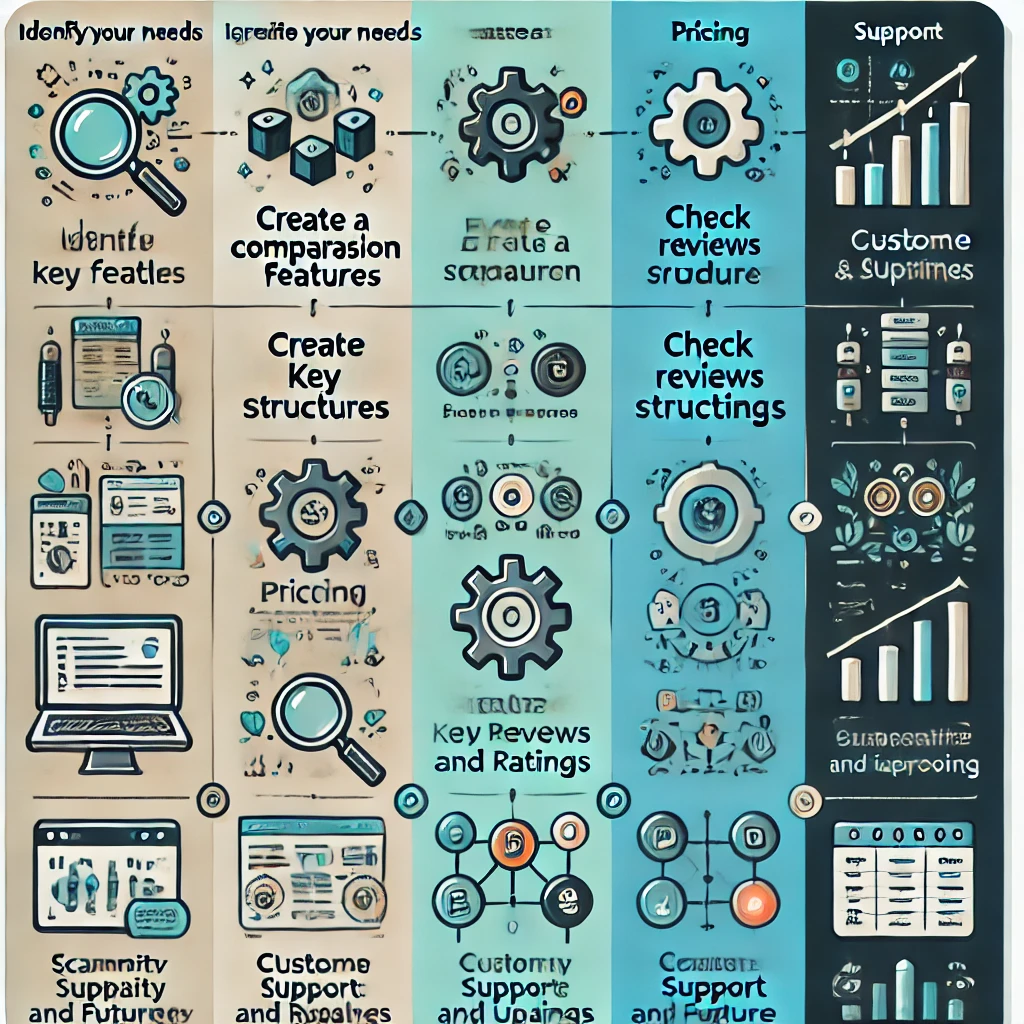When comparing software products, it’s important to use a systematic approach to evaluate key features, benefits, and potential drawbacks. Here’s a step-by-step guide to comparing software products effectively:


1. Identify Your Needs
- Define Purpose: Clarify the main goals of the software. Are you looking for project management, CRM, accounting, etc.?
- List Key Features: Write down the essential features your business or personal use needs. For example, for a CRM, you might need lead management, email integration, and reporting tools.
- Budget Constraints: Set a budget for the software to filter out those that exceed your financial plan.
2. Create a Comparison Table
- Make a table to organize your research, listing features on the rows and software products in the columns. Include:
- Core Features (specific to the software’s purpose)
- Pricing Models (one-time vs. subscription)
- Ease of Use (interface and learning curve)
- Integration Capabilities (with other software you use)
- Customer Support (availability and response time)
- Scalability (whether it can grow with your business)
3. Evaluate Key Features
- Usability: How intuitive is the software? Does it offer an easy learning curve? Testing free trials or demo versions can help with this.
- Customization Options: Can you tailor the software to your business needs? Look for personalization features like dashboards, workflows, or user permissions.
- Performance: Assess the software’s speed and reliability. Is it cloud-based or on-premise? Consider performance on various devices if you need mobile functionality.
- Security: Verify if the software has robust security protocols like encryption, two-factor authentication, and compliance with industry standards (like GDPR, HIPAA).
- Integration: How well does it integrate with other tools you’re using? Seamless integration reduces manual tasks and increases efficiency.
4. Pricing Structure
- Cost Comparison: Compare the pricing tiers of each software. Some tools offer tiered pricing based on features or user counts.
- Free Trials: Take advantage of free trials or freemium versions to get a hands-on feel.
- Hidden Costs: Check for hidden costs like setup fees, premium features, or required training.
5. Check Reviews and Ratings
- Professional Reviews: Sites like Ecommerce25 or other software review platforms provide expert insights into the pros and cons of various products.
- User Reviews: Look at user-generated reviews for real-world experiences. Consider both positive and negative feedback.
- Case Studies: Look for case studies showing how businesses similar to yours have benefited from the software.
6. Customer Support and Updates
- Support Availability: Consider the availability of support channels like live chat, email, or phone support.
- Response Times: Quick and efficient customer support is essential for minimizing downtime or issues.
- Software Updates: Ensure the software has a history of regular updates and improvements, which indicates that the product is evolving to stay competitive.
7. Scalability and Future-Proofing
- Scalability: Can the software scale as your business grows? You don’t want to outgrow a solution quickly.
- Future-Proofing: Look for signs that the software is continuously updated with new features to stay ahead of trends.
8. Testing and Feedback
- Trial Runs: Conduct trials with a small team or department to test the software in a real-world scenario.
- Gather Feedback: Collect feedback from the team members who will use the software most often to see how it fits their workflows.
9. Make the Final Decision
- After evaluating and testing, revisit your comparison table and weigh the pros and cons of each solution. Choose the software that meets your needs, budget, and future growth plans best.
Example Comparison:
If you’re comparing CRM software like HubSpot, Salesforce, and Zoho CRM, your comparison might look like this:
| Features | HubSpot CRM | Salesforce | Zoho CRM |
|---|---|---|---|
| Pricing | Free, Paid tiers | High-tiered | Affordable |
| Usability | Easy | Moderate | Moderate |
| Integration | Great | Excellent | Good |
| Customization | High | Very high | Moderate |
| Customer Support | Good | Excellent | Fair |
| Scalability | Good | Excellent | Good |
By using a method like this, you can make more informed decisions when choosing the right software for your needs.
